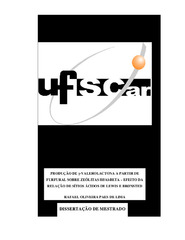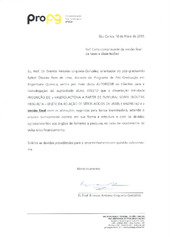Mostrar el registro sencillo del ítem
Produção de γ-valerolactona a partir de furfural sobre zeólitas Hf/Al-beta – efeito da relação de sítios ácidos de Lewis e Brønsted
| dc.contributor.author | Lima, Rafael Oliveira Paes de | |
| dc.date.accessioned | 2020-05-22T00:16:48Z | |
| dc.date.available | 2020-05-22T00:16:48Z | |
| dc.date.issued | 2020-03-19 | |
| dc.identifier.citation | LIMA, Rafael Oliveira Paes de. Produção de γ-valerolactona a partir de furfural sobre zeólitas Hf/Al-beta – efeito da relação de sítios ácidos de Lewis e Brønsted. 2020. Dissertação (Mestrado em Engenharia Química) – Universidade Federal de São Carlos, São Carlos, 2020. Disponível em: https://repositorio.ufscar.br/handle/ufscar/12743. | * |
| dc.identifier.uri | https://repositorio.ufscar.br/handle/ufscar/12743 | |
| dc.description.abstract | Lignocellulosic biomass has been used as a sustainable alternative to organic derivatives of fossil origin for the production of intermediates and chemicals with higher added value. In this context, γ-valerolactone (GVL), a compound used as a solvent, fuel additive or intermediate in the synthesis of fine chemical products, can be produced from bioderivated furfural. Currently, GVL is produced using high pressures in the hydrogenation in steps of levulinic acid (AL), using catalysts containing noble metals (e.g., Ru and Pd) and molecular hydrogen. As an alternative to this process, Meerwein-Ponndorf-Verley (MPV) transfer hydrogenation allows selective hydrogenation of furfural and hence AL, over Lewis (L) and Brønsted (B) acid sites, using a secondary alcohol as a hydrogen donor. As known, zeolites have high potential as heterogeneous catalysts, as their acidic and textural properties can be designed to meet specific reaction systems. Thus, type of structure, porosity and ratio of acidic L and B sites will be determining factors in the activity for this series reaction. An optimized balance of the L/B ratio can be achieved by the isomorphic substitution of structural Al3+ in the zeolite by Hf4+ atoms increasing Lewis acidity. Zeolites (Al/Hf)-Beta have been shown to be more efficient in MPV reactions than zeolites (Al/Zr)-Beta or (Al/Sn)-Beta. Thus, the objective of the work was to prepare catalysts (Al/Hf)-Beta by post-synthesis strategies and to investigate the influence of the L/B ratio, in the conversion in series of furfural to GVL, using isopropanol and carried out at atmospheric pressure, 120 °C, 150 mmol L-1 of furfural in isopropanol and 30 mg of catalyst. The precursor and modified beta zeolites were characterized by X-ray dispersive energy spectroscopy and scanning electron microscopy (SEM/EDS), X-ray diffraction (DRX), N2 physisorption, ammonia desorption at the programmed temperature (DTP-NH3) and diffuse reflectance spectroscopy in Fourier transform infrared (DRIFTS) and visible ultraviolet (DRS-UV-Vis). The results showed that the grafting treatment was efficient in the incorporation of hafnium in the beta zeolite structure, increasing the L/B acidity ratio and making it selective for the conversion into series of furfural, obtaining under the conditions used a yield at 46% GVL after 22.5 h of reaction. | eng |
| dc.description.sponsorship | Conselho Nacional de Desenvolvimento Científico e Tecnológico (CNPq) | por |
| dc.language.iso | por | por |
| dc.publisher | Universidade Federal de São Carlos | por |
| dc.rights | Attribution-NonCommercial-NoDerivs 3.0 Brazil | * |
| dc.rights.uri | http://creativecommons.org/licenses/by-nc-nd/3.0/br/ | * |
| dc.subject | Furfural | por |
| dc.subject | γ-valerolactona | por |
| dc.subject | Zeólita Beta | por |
| dc.subject | Háfnio | por |
| dc.subject | Sítios ácidos de Lewis e Brønsted | por |
| dc.subject | γ-valerolactone | eng |
| dc.subject | Beta zeolite | eng |
| dc.subject | Grafting | eng |
| dc.subject | Hafnium | eng |
| dc.subject | Lewis and Brønsted acid sites | eng |
| dc.title | Produção de γ-valerolactona a partir de furfural sobre zeólitas Hf/Al-beta – efeito da relação de sítios ácidos de Lewis e Brønsted | por |
| dc.title.alternative | Production of γ-valerolactone from furfural on Hf/Al-beta zeolites - effect of the relationship of Lewis and Brønsted acid sites | eng |
| dc.type | Dissertação | por |
| dc.contributor.advisor1 | Urquieta-González, Ernesto Antonio | |
| dc.contributor.advisor1Lattes | http://lattes.cnpq.br/2389975677904655 | por |
| dc.description.resumo | Biomassa lignocelulósica vêm sendo utilizada como alternativa sustentável à derivados orgânicos de origem fóssil para a produção de intermediários e produtos químicos de maior valor agregado. Neste contexto, a γ- valerolactona (GVL), composto utilizado como solvente, aditivo de combustíveis ou intermediário na síntese de produtos de química fina, pode ser produzido a partir do furfural bioderivado. Atualmente a GVL é produzida utilizando altas pressões na hidrogenação em etapas do ácido levulínico (AL), utilizando catalisadores contendo metais nobres (e.g., Ru e Pd) e hidrogênio molecular. Como alternativa a esse processo, a hidrogenação por transferência do tipo Meerwein-Ponndorf-Verley (MPV), permite a hidrogenação seletiva de furfural e deste a AL, sobre sítios ácidos de Lewis (L) e Brønsted (B), utilizando um álcool secundário como doador de hidrogênio. Como conhecido, zeólitas apresentam elevado potencial como catalisadores heterogêneos, pois suas propriedades ácidas e texturais podem ser planejadas para atender a sistemas de reação específicos. Assim, tipo de estrutura, porosidade e relação de sítios ácidos de L e B serão fatores determinantes na atividade para essa reação em série. Um balanço otimizado da relação L/B poderá ser alcançada pela incorporação isomórfica de átomos de Hf, que geram acidez de L, nas vacâncias do Al3+ estrutural na zeólita. Zeólitas (Al/Hf)-Beta têm se mostrado mais eficientes em reações MPV do que zeólitas (Al/Zr)-Beta ou (Al/Sn)-Beta. Dessa forma, o objetivo do trabalho foi preparar catalisadores (Al/Hf)-Beta por estratégias pós-síntese e investigar a influência da relação L/B, na conversão em série de furfural a GVL, utilizando isopropanol e realizada à pressão atmosférica, 120 °C, 150 mmol L- 1 de furfural em isopropanol e 30 mg de catalisador. As zeólitas beta precursora e modificadas foram caracterizadas por espectroscopia de energia dispersiva de raios X e microscopia eletrônica de varredura (MEV/EDS), difratometria de raios X (DRX), fisissorção de N2, dessorção de amônia à temperatura programada (DTP-NH3) e espectroscopias de reflectância difusa no infravermelho por transformada de Fourier (DRIFTS) e no ultravioleta visível (DRS-UV-Vis). Os resultados mostraram que o tratamento por grafting foi eficiente na incorporação de háfnio na estrutura da zeólita beta, aumentando a relação de acidez L/B e tornando-a seletiva para a conversão em série de furfural, obtendo-se nas condições utilizadas um rendimento a GVL de 46% após 22,5 h de reação. | por |
| dc.publisher.initials | UFSCar | por |
| dc.publisher.program | Programa de Pós-Graduação em Engenharia Química - PPGEQ | por |
| dc.subject.cnpq | ENGENHARIAS::ENGENHARIA QUIMICA | por |
| dc.description.sponsorshipId | CNPq: 130138/2019-3 | por |
| dc.publisher.address | Câmpus São Carlos | por |
| dc.contributor.authorlattes | http://lattes.cnpq.br/3441857290402335 | por |


